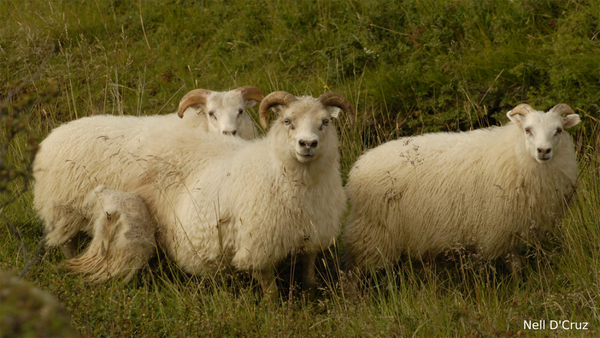Know Your Fiber: Icelandic Wool
Posted on March 31 2018

Icelandic sheep are one of the oldest breeds of sheep still in existence. Descended from the first short-tailed sheep to arrive in Northern Europe during the Paleolithic Age, these hardy sheep still populate most of Iceland’s sheep herds today, producing meat, milk, and sturdy wool.
Archaeological evidence suggests that first short-tailed sheep arrived in southern Europe from the Middle East around 6000 BCE, and arrived in the northernmost parts of Europe sometime between 4000-3000 BCE. These early sheep were valued primarily for their meat and their wool. Interestingly, the wool of these early sheep didn’t require shearing, as Icelandic sheep do today; they shed their wool, meaning that it could be gathered by hand from the sheep.
There is very little in the way of ancient Nordic art or mythology regarding sheep, although a number of tools and pieces of art have been found from Bronze to Iron Age excavations with goat artwork. However, some breeds of sheep descended from these of these early forbearers have distinctly goat-like body and horn characteristics. As such, it has been hypothesized that some of the early artwork assumed to depict goats may be depicting sheep. As for mention in tales and mythology, the only known mention of sheep from these times is from the Poetic Edda, a collection tales from earlier Scandinavian periods compiled by Snorri Sturluson in the 13th century. In this collection, the god Heimdall, a god with acute physical senses and the gift of foreknowledge, is said to have hearing so keen that he could hear wool as it grew on sheep.
Even though not much information about early Nordic sheep has survived from early art or mythology, there is plenty of evidence showing sheep were being raised. Archaeological digs have turned up sheep bones and dung at excavations, and there is no denying the important role sheep came to play in providing food, warm clothing, and more for people in the northernmost part of Europe. Indeed, without sheep there would have been no Vikings.
Wool was critical to the development of the Norse as a seafaring folk. It was used in clothing for its ability to keep them warm, even as they got wet from waves and weather. Although knitting and crochet had yet to be invented at this point in history, wool in Scandinavia was spun into yarn and turned into cloth through weaving or through nålebinding, a single needle technique that produces fabric through interlocking loops. Nålebinding is thought by some to be a predecessor of knitting; the finished fabric looks very similar to knitting, and the remains of early nålebinding has even been initially mistaken for knitting by some archaeologists. Thick, woolen blankets called sjøryas, similar to shaggy, knotted rugs, were also used by early Viking sailors to keep warm.
Most importantly, though, wool allowed Vikings to develop boats with sails. Sails first arrived in the Nordic parts of Europe in the early part of the 8th century, and wool was what made them possible. Unlike sailors from the Mediterranean, the people in northern Europe didn’t have easy access to the quantities of flax required for linen sails. But they did have sheep. Even more fortunately, the sheep from Scandinavia at this time, like the Icelandic sheep that survive to this day, were double coated. These sheep produced a fine undercoat, and also produced a longer outercoat. Those fibers were separated when producing sails so that the longer hairs were used for the warp, while the finer, lofty hairs were used for the weft. Once woven, the cloth was fulled to reduce the space between fibers, which meant the woolen sails could better catch the wind. The lanolin in the wool would have provided some protection against the elements, although there is also evidence that at least some of these woolen sails were further treated with a resin made from fir tar, fish oil and tallow to make them even more resistant to breakdown by water and salt. These processes made an exceptionally effective and long-lasting sail, which allowed the Vikings to explore and colonize lands in the throughout Europe and the northern Atlantic. It also created a boom in sheep farming. Outfitting just one Viking ship and its crew with sails, clothing, and blankets required the wool from a thousand or more sheep. It is estimated that by the mid-11th century, outfitting the entire Viking fleet would have taken a year’s worth of wool from 2 million sheep.
It took Vikings less than one hundred years to begin to use their newly acquired sails to begin to raid and explore the rest of Europe. But, at pretty much the same time, the Norse also began to discover lands previously unknown to Europeans across the northern Atlantic Ocean; these lands included Iceland, Greenland, and even North America. In 861, a man by the name of Naddodd was blown off course while sailing to the Faroe Islands from Norway. He became the first Norseman to discover this previously undiscovered land, which he called Snæland (Snowland). When he returned home he told tales of this place, prompting Floki Vilgerdarson, his family, and a few other Norse explorers to set out to find it six years later; Floki renamed the new land Ísland (Iceland). Just a few years after that, in 870, people began to settle in Iceland, bringing with them the sheep that would become the breed known today as Icelandic sheep.
The Icelandic environment shaped the Norse settlers’ sheep into a new breed. It was difficult to grow large quantities of grain or hay in Iceland, which meant the most successful sheep were those that could survive by foraging from the natural landscape. These challenging farming conditions in Iceland quickly created a very sturdy sheep with a strong constitution. These conditions also reinforced the maintenance of a smaller, separate line within the Icelandic sheep breed – leadersheep. Leadersheep were an integral part of what allowed Icelandic farmers to manage their herds. Identifiable by their longer legs and lighter weight, these sheep were (and still are) bred for their intelligence, rather than for their wool, milk or meat. Leadersheep, as the name implies, are responsible for leading the flock out to pasture. They fulfill much of the same role that sheepdogs do in other flocks, keeping the flock together while going out to and returning from pasture, keeping the flock calm when necessary, and alerting the flock to danger from predators. Some farmers claim that leadersheep can even predict the weather by refusing to lead the flock out to pasture when the weather is about to take a turn for the worse, or even lead the flock home on their own ahead of a bad storm.
The relative isolation of Iceland from Europe meant that Icelandic sheep retained many of the same characteristics of the original sheep brought over by the original settlers, including the double-coat that makes this breed so valued. Because of the relatively small amount of change that has occurred with the breed over the last thousand or so years, Icelandic sheep are one of a handful of the oldest sheep breeds in the world. Today, Icelandic sheep can be found around the world. However, the majority of Icelandic sheep are still found in Iceland, where they outnumber humans by about half. This has led some people to joke that the popularity of woolen sweaters in Iceland is at least in part so that humans can blend in better with the majority sheep population.
Icelandic wool is a sturdy and durable wool, best suited for outerwear. In additional to being popular among knitters, crocheters, and weavers, it is also a favorite among crafters for felting. Icelandic sheep are typically sheared twice per year, and produce between 4-7 pounds of wool. The outer coat, called tog, is a true wool and should not be confused as being the same thing as the longer guard hairs on other breeds of sheep. It can grow to 6-8 inches in just 6 months, and is particularly lustrous as well as quite strong and durable at a count of 27-30 microns. The fine undercoat is called Þel (pronounced “thel”), which grows to 2-4 inches in length and has a micron count of 19-22. Traditionally, these two fibers are spun together to create a yarn called Lopi, which is traditionally used to knit Lopapeysa, the classic Icelandic sweater with a color-work yoke that first became popular in the 1950s, and remains popular to this day.
Looking for some Lopi of your own? Stop by the shop and pick up some Léttlopi, a worsted weight, Icelandic wool yarn direct from Iceland. We look forward to seeing you there!
Icelandic Sheep Photo by Nell D'Cruz. Creative Commons Image License 2.0

Follow US